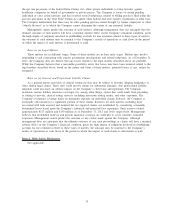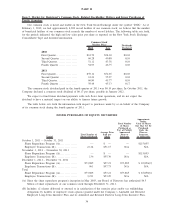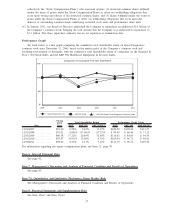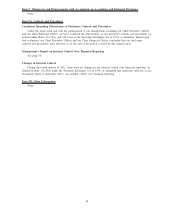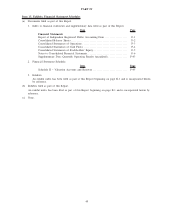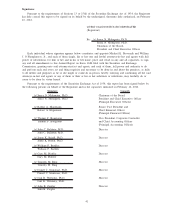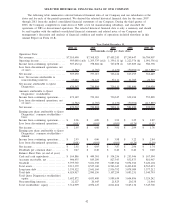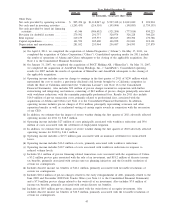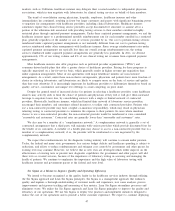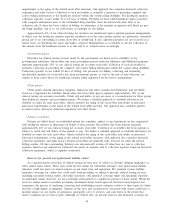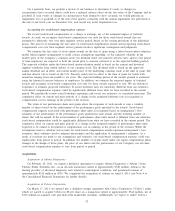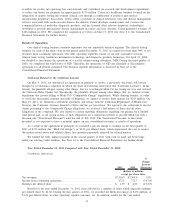Quest Diagnostics 2011 Annual Report Download - page 51
Download and view the complete annual report
Please find page 51 of the 2011 Quest Diagnostics annual report below. You can navigate through the pages in the report by either clicking on the pages listed below, or by using the keyword search tool below to find specific information within the annual report.QUEST DIAGNOSTICS INCORPORATED AND SUBSIDIARIES
MANAGEMENT’S DISCUSSION AND ANALYSIS OF FINANCIAL CONDITION
AND RESULTS OF OPERATIONS
Overview
Our Company
Quest Diagnostics is the world’s leading provider of diagnostic testing, information and services, providing
insights that enable patients and physicians to make better healthcare decisions. Quest Diagnostics, with a leading
position in most of its domestic geographic markets and service offerings, is well positioned to benefit from the
long-term growth expected in the industry. Over 90% of our revenues are derived from clinical testing with the
balance derived from risk assessment services, clinical trials testing, diagnostic products and healthcare
information technology. Clinical testing is generally categorized as clinical laboratory testing and anatomic
pathology services. Clinical laboratory testing is generally performed on whole blood, serum, plasma and other
body fluids, such as urine, and specimens such as microbiology samples. Anatomic pathology services are
principally for the detection of cancer and are performed on tissues, such as biopsies, and other samples, such as
human cells. We are the leading cancer diagnostics testing provider focused on anatomic pathology and molecular
diagnostics, and provide interpretive consultation through the largest medical and scientific staff in the industry,
with hundreds of M.D.s and Ph.D.s, primarily located in the United States. In addition, we are the leading
provider of gene-based and esoteric testing, the leading provider of risk assessment services for the life insurance
industry in North America and a leading provider of testing for drugs-of-abuse in the United States. We are also
a leading provider of testing for clinical trials. Our diagnostics products business manufactures and markets
diagnostic test kits and specialized point-of-care testing. We also empower healthcare organizations and clinicians
with robust information technology solutions.
The Clinical Testing Industry
Clinical testing is an essential element in the delivery of healthcare services. Physicians use laboratory tests
to assist in the detection, diagnosis, evaluation, monitoring and treatment of diseases and other medical
conditions.
Most laboratory tests are performed by one of three types of laboratories: commercial clinical laboratories;
hospital-affiliated laboratories; or physician-office laboratories. In 2011, we estimate that hospital-affiliated
laboratories accounted for approximately 60% of the market, commercial clinical laboratories approximately one-
third and physician-office laboratories the balance.
Orders for laboratory testing are generated from physician offices, hospitals and employers and can be
affected by a number of factors. For example, changes in the United States economy can affect the number of
unemployed and uninsured, and design changes in healthcare plans can affect the number of physician office and
hospital visits, and can impact the utilization of laboratory testing.
The diagnostic testing industry is subject to seasonal fluctuations in operating results and cash flows.
Typically, testing volume declines during the summer months, year-end holiday periods and other major holidays,
reducing net revenues and operating cash flows below annual averages. Testing volume is also subject to declines
due to severe weather or other events, which can deter patients from having testing performed and which can
vary in duration and severity from year to year.
Key Trends
There are a number of key trends that we expect will have a significant impact on the clinical testing
business in the United States and on our business. In addition to the economic slow down in the United States
which we believe has temporarily reduced industry growth rates, these trends present both opportunities and risks.
However, because clinical testing is an essential healthcare service and because of certain of the key trends
discussed below, we believe that the clinical testing industry will continue to grow over the long term and that
we are well positioned to benefit from the long-term growth expected in the industry. The key trends that we
expect will have a significant impact on the clinical testing business include:
•the growing and aging population;
•continuing research and development in the areas of genomics (the study of DNA, genes and
chromosomes) and proteomics (the analysis of individual proteins and collections of proteins), which is
expected to yield new, more sophisticated and specialized diagnostic tests;
•increasing recognition by consumers and payers of the value of laboratory testing as a means to improve
health and reduce the overall cost of healthcare through early detection and prevention;
45


